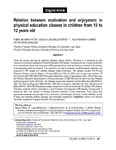Relation between motivation and enjoyment in physical education classes in children from 10 to 12 years old

Use this link to cite
http://hdl.handle.net/2183/37483
Except where otherwise noted, this item's license is described as Atribución-NoComercial-SinDerivadas 4.0 Internacional
Collections
- Investigación (FCS) [1293]
Metadata
Show full item recordTitle
Relation between motivation and enjoyment in physical education classes in children from 10 to 12 years oldAuthor(s)
Date
2019Citation
Navarro Patón, R., Lago Ballesteros, J., Basanta Camiño, S., & Arufe Giráldez, V. (2019). Relation between motivation and enjoyment in physical education classes in children from 10 to 12 years old. Journal of Human Sport and Exercise: JHSE, 14(3), 527-537. https://doi.org/10.14198/JHSE.2019.143.04
Abstract
[Abstract]: There are serious warnings of sedentary lifestyles among children. Therefore, it is necessary to take
measures from school, especially in Physical Education (PE) classes. One way to do this, it is paying attention
to the motivational climate and enjoyment in PE classes because these two factors are related to the intention
to be physically active by students. This research’s aim was to evaluate multidimensional motivation and
enjoyment in PE classes and relations between these dimensions. The sample included 315 Primary
Education Galician students (Spain), 145 boys (46%) and 170 girls (54%), with an age range between 10
and 12 years (M=10.92, SD=0.792). Data were collected by means of two questionnaires. One of them was
the ‘Physical Education Questionnaire in Primary Education´ (CMEF-EP), and the other one was ‘Physical
Activity Enjoyment Scale´ (PACES). The following results were obtained: Intrinsic Motivation (IM) (M=5.12;
SD=1.14), External Regulation (ER) (M=3.61; SD=1.63), Amotivation (AM) (M=1.93; SD=1.46), Enjoyment
(ENJ) (M=4.51; SD=0.55). Regression analysis shows that the IM can predict 42.1% of ENJ in PE classes.
Therefore, students’ intrinsic motivation is a solid framework for enjoyment in PE lessons. Consequently, it
should be taken into account by Primary Education teachers in their classrooms. They should take
appropriate measures to encourage intrinsic motivation: methodologies of inquiry, positive feedback, variety
of tasks and materials, flexible grouping and meaningful assessment.
Keywords
Intrinsic and extrinsic motivation
Enjoyment
Physical education
Primary education
Enjoyment
Physical education
Primary education
Editor version
Rights
Atribución-NoComercial-SinDerivadas 4.0 Internacional
ISSN
1988-5202






